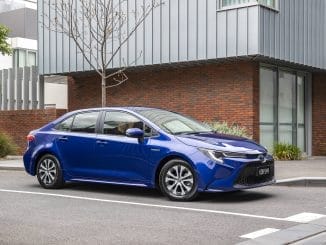I got along to the Australian launch of the all-new Toyota crossover/small SUV, the C-HR, in February.
So getting a chance to get to know the interesting new addition to the Toyota range over a longer period of time was appreciated.
This time around I had the entry-level model, fitted though with the optional all-wheel drive.
I remain of the opinion that the Toyota C-HR will be a commercial success for Toyota, however there are a couple of things about it that might stop it from winning over some buyers.
 First of all the rear visibility is an issue, especially rear 3/4 visibility.
First of all the rear visibility is an issue, especially rear 3/4 visibility.
This issue is likely to be a turn-off for some.
Interior space is nothing to write home about either, it’s adequate, but barely larger than a Corolla inside, especially in the rear.
Lastly, the engine. A 1.2 litre turbo-petrol unit, it is willing, but somewhat brings the C-HR experience down.
The problem is two-fold – the shear weight of the C-HR and the CVT auto.
Tipping the scales around a hefty 200kg more than a Corolla hatch, the 85kW/185Nm produced by the engine is only just enough to comfortably haul the crossover/small SUV around.
While the CVT transmission tends to not help as much as it could because of a propensity to want to shift up too early.
The transmission then is not quite as enthusiastic about giving you a lower ratio when required i.e. when climbing a hill.
In comparison, the lighter and smaller Corolla has a 1.8 litre naturally-aspirated engine that gives you significantly more power (103kW) and slightly less torque (173Nm)
The word then that comes to mind with the Toyota C-HR engine/transmission is ‘adequate’ and that’s a shame in a vehicle that is great to look at and is otherwise generally very likeable.
The big positive that I found in the C-HR is the ride and handling, both aspects are really nicely sorted.
The forward visibility is good too, and the wing mirrors are nice and wide (given the visibility issue this is a good thing!).
The seats are comfortable and the fit and finish throughout the vehicle is top notch.
Cabin storage areas are generally adequate, or slightly above average, especially the centre console bin.
Speaking of the centre console, it has an interesting concave shape and this helps items roll into it, rather than off it.
Well-placed cup holders are welcome and the controls are simple, and well-placed.
There’s also a heap of headroom for taller drivers.
There is only one USB charge point and that is on the infotainment head unit (an odd spot), while there’s a standard 12V outlet in the centre bin.
I’m not crazy about the placement of a support beam on the floor just ahead of the front seats – this is an area where I often rest my left foot on longer drives.
The cabin is well-insulated, however you can hear the engine, especially when it’s working hard (which could be often) and there was some noticeable tyre noise, especially more prominent on rougher surfaces.
 Summing it up, if you’re thinking of jumping out of a hatch and into a C-HR then you shouldn’t expect a lot more for your extra dollars.
Summing it up, if you’re thinking of jumping out of a hatch and into a C-HR then you shouldn’t expect a lot more for your extra dollars.
It’s a nice vehicle to look at, displays great road manners and is quality throughout.
Does the Toyota C-HR make perfect sense though? Well not really, especially given the somewhat disappointing engine/transmission combo.
Facts and Figures: 2017 Toyota C-HR
- Engine: 1.2 litre turbo-petrol producing 85kW/185Nm
- Transmission: CVT auto only
- Safety: Five stars
- Warranty: 3yrs/100,000km
- Origin: Japan
- Price: from $26,990 and $28,990 (AWD)





Be the first to comment